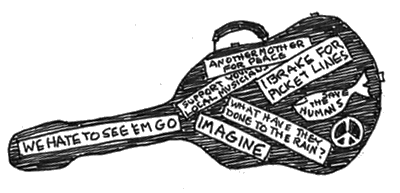


The
other day at Jimmy Bean’s, my favorite internet cafe/restaurant, my
daughter Nancy Beth (visiting from the Northwest) took me on my first
tour of Second Life. This is an online virtual world that differs from
role-playing games in that you don’t send your avatar on
adventure-quests, you just hang out, go to the clubs, shop, whatever.
And instead of choosing whether to confront the dragon or ambush him,
you are deciding what to wear (action heroes don’t do much of that). If
you want something more distinctive than standard wear for your avatar
to hang out in, you can buy designer clothes with Linden dollars, the
local currency of Second Life, and the designer can convert them to US
dollars.
So
my daughter, in addition to being a web site designer (she designed and
keeps up mine) is now a clothing designer in Second Life. She tells me
that SL residents are more evenly divided between male and female than
the game players, which are heavily male, and I can see why this is so.
It is Techie meets Barbie. You can program your avatar to do more than
the standard walk and fly, or, if you don’t want the hassle, you can buy
an animation somebody else has made, and your avatar can then do that.
So you can buy clothes in Nancy Beth’s virtual store, but you can buy an
animation as well, buy for your avatar the ability to make a snow
angel. So pretend play has been brought to a whole new level, and for
grown-ups (there is also a teen section).
Second
Life seems limited and slow compared to children’s unfettered imaginary
play—but children’s imagination can be fettered, too. I remember a
storyteller telling me about watching two children play with action
figures, and one kid saying “You can’t do that” because the other kid’s
action figure was not endowed with that particular power in the TV
program it had spun off from. So dolls and action figures pre-programmed
in kids’ minds by TV aren’t as flexible as a generic doll whose
abilities are bound only by the limits of what a child can think up. I
have heard of preschools that ban toys brought from home for this
reason, but I have also heard of a preschool that has no toys at all—so
the children have only their imaginations. This may not be a bad idea
The
upside of Second Life is that your imaginary self gets to travel into
representations of other people’s imaginations and interact with them.
After my daughter and I got home (from Second Life and from Jimmy
Bean’s) it occurred to me that my grandfather’s tailor shop now has a
virtual branch in cyberspace.
My
daughter and I are living a different kind of second life, which
started when we found each other through a registry when she was
thirty-seven, fifteen years ago. Before I gave her up for adoption I had
seen her only once, at a few days old, and never held her. I was in
college, and single, and not wanting to marry the father, a good guy but
wrong for me, and mainly it was 1955, and nice girls didn’t become
single mothers back then. Her adoptive parents named her Nancy, not
knowing my name; we call her Nancy Beth to avoid confusion (they call me
Big Nancy).
I
wrote a performance piece about our reunion and have performed it both
alone and with Nancy Beth—maybe I’ll post some excerpts of that here
eventually. We are now good friends. She is a natural storyteller, and
we have written one song together.
©2007 by Nancy Schimmel

Monday, April 16, 2007


RECESS II, SECOND LIFE






